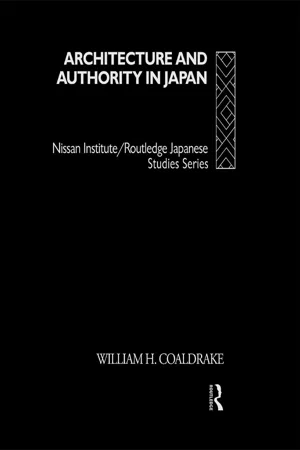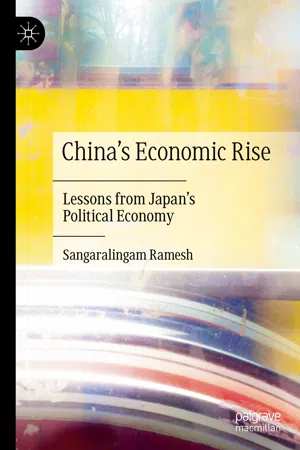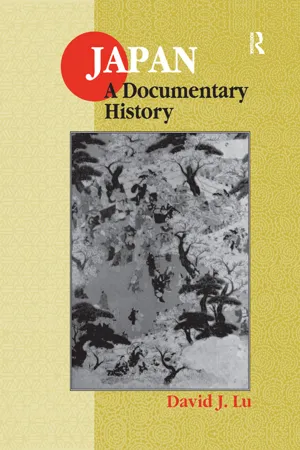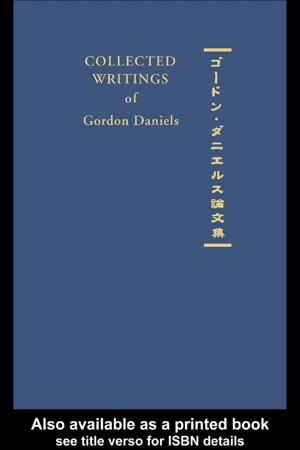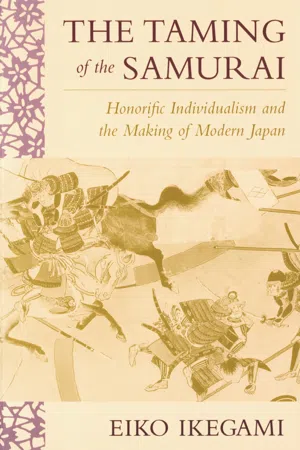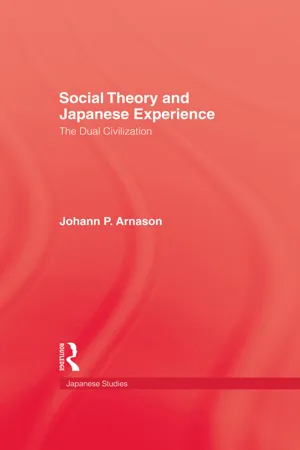History
Kamakura Shogunate
The Kamakura Shogunate was a feudal military government established in Japan in 1185 by Minamoto no Yoritomo. It marked the beginning of the shogunate system, with the shogun holding real power while the emperor's role became largely ceremonial. The Kamakura period was characterized by a decentralized feudal system and the emergence of samurai as a dominant social class.
Written by Perlego with AI-assistance
Related key terms
9 Key excerpts on "Kamakura Shogunate"
- eBook - ePub
- Jeremy Black(Author)
- 2005(Publication Date)
- Routledge(Publisher)
Chapter ThreeWarfare in Japan 1467–1600Paul VarleyJapan in the mid-fifteenth century was a country on the verge of disintegration. Its emperor, whose court was located in Kyoto, had not exercised real authority for centuries, but was a “sacred legitimizer” of the rule of others. From the late twelfth century, when the first warrior—samurai—government was established at Kamakura in the Kant or eastern provinces (a government known in English as “shogunate”, because its head was the shogun or “generalissimo”), the effective rulers of the land were warrior chiefs. The Kamakura Shogunate spanned the years 1185–1333, and was replaced, after a brief hiatus, by the Ashikaga Shogunate, 1336–1573, which was situated in Kyoto in proximity to the emperor and his court and headed by shoguns of the Ashikaga family.The Ashikaga Shogunate came into existence in 1336 at the commencement of a sanguinary conflict, known as the War Between the Courts, that was not settled until 1392. Even after this war the Shogunate was able to exercise only limited control of the country. Its leader, the shogun, presided as hegemon over semi-independent warrior chiefs invested by him as constables (shugo) of the various provinces (66 in all) into which Japan was divided. But distant areas of the country, especially the island of Kyushu in the west and the northern reaches of the main island of Honshu, were largely beyond effective Shogunate administration, and in the early fifteenth century the vital Kant region, heartland of the warrior class, also slipped from Shogunate control and lapsed into disunion. During the nin War, 1467–77, the Ashikaga Shogunate was reduced to nearimpotence, and Japan itself was plunged into the age of Sengoku or “The Country at War”, 1467–1568.1 - Karl F. Friday(Author)
- 2004(Publication Date)
- Routledge(Publisher)
As it happened, the powers-that-were in the court were just as unhappy with Yoritomo's enemies – the Taira, and Minamoto Yoshinaka – as they were with him. In contrast to the circumstances prevailing during previous warrior uprisings, the events of the 1180s left the court with no more palatable choice available to send as champion against Yoritomo, making rapprochement with him the least of several evils.The resulting Kamakura Shogunate was in effect a government within a government, at once a part of and distinct from the imperial court in Kyoto. Dominated after Yoritomo's death by the Hōjō family, who established a permanent regency over a succession of figurehead shoguns, the regime exercised broad administrative powers over the eastern provinces, and held special authority over the warriors, scattered nationwide, whom it recognized as its formal vassals (gokenin ). After the Jōkyū War of 1221, an ill-fated attempt by a retired emperor, Go-Toba, to eliminate the shogunate, the balance of real power shifted steadily toward Kamakura and away from Kyoto. By the end of that century, the shogunate had assumed control of most of the state's judicial, military and foreign affairs.In the meantime, gokenin across the country discovered that they could manipulate the insulation from direct court supervision Kamakura offered them in order to lay ever stronger and more personal claims to lands – and the people on them – which they ostensibly administered on behalf of the powers-that-were in the capital. Through a ratcheting process of gradual advance by fait accompli , a new warrior-dominated system of authority absorbed the older, courtier-dominated one, and real power over the countryside spun off steadily from the center to the hands of local figures.24By the second quarter of the fourteenth century, this evolution had progressed to the point where the most successful of the shogunate's provincial vassals had begun to question the value of continued submission to Kamakura at all. The regime fell in 1333, as the result of events spawned by an imperial succession dispute.- eBook - ePub
- William H. Coaldrake(Author)
- 2002(Publication Date)
- Routledge(Publisher)
These sombre words seem to apply equally to the buildings which represented authority in the Heian capital. The Sanjo Palace and Michinaga’s Tsuchimikado-dono were a case of pride having its inevitable fall, for they proved to be as ‘unsubstantial as a dream on a spring night’. Those who are born to rule also have an affinity, it would seem, with buildings which are made to be destroyed.Architecture and the Contemplative Counterpoise to Warrior Authority
In the Kamakura period (1185–1333), authority takes on a more aggressive countenance with the usurpation of the power of the court aristocracy by regional warrior bands. The process culminated with the victory of the Minamoto over the Taira in 1185 and the establishment of a military headquarters or shogunate at Kamakura, the local power base of the Minamoto. The complex nature of authority in the Kamakura period is frequently described by the term ‘diarchy’ or dual authority, for in reality there were two governments, the old civilian government of the Heian court and the new ‘tent government’ or bakufu of the Kamakura warriors.26 After the demise of the founding Kamakura shogun Minamoto Yoritomo, the family of Hojo Masako, his formidable wife, was to govern as regents to a series of titular shogun until its overthrow in 1333. Thus we have a situation in which the Hojo were exercising power in the name of a figurehead shogun, who himself derived title and claim to legitimacy from the authority of the emperor. The governmental structure of Kamakura operated on the basis of a fine interweaving of feudal-type loyalties in a multi-layered hierarchy of lords and vassals. Kamakura control extended into the regions through a system of jito and shugo, or estate stewards and provincial governors.Central to the conventional interpretation of authority in Japanese medieval history has been our understanding that the title sei-i-tai shogun or ‘barbarian subduing generalissimo’ was conferred upon Minamoto Yoritomo by the imperial throne as legitimising his position as military hegemon. It is equally well known that this title was assumed only in 1192, some seven years after the defeat of the Taira forces at Dan no Ura in 1185. It is far more significant for our present discussion to recognise that this title was of little contemporary significance during the early stages of Yoritomo’s eminence, and that the emphasis upon the shogunal title comes from interpretations of later history. In the fluid political situation following the Minamoto victory of 1185, several titles were in fact used for Yoritomo, only one of which was shogun. For example, Jeffrey Mass notes that shogun was used as a title for some documents emanating from the new administration in Kamakura but that ‘the office of shogun was neither retained by Yoritomo until his death [in 1199], nor bequeathed to his son and successor Yoriie.’27 Yoritomo instead made personal use of his earlier court title of utaisho, a position of commander in the inner palace guards, while being referred to commonly by his own vassals as tono.28 The lack of standardisation of titular reference reveals uncertainty about the appropriate way of signifying new authority and the coexistence of different functional roles, but the point of reference is frequently architectural. Tono meant both ‘palace’ and ‘lord’. The character occurs as a suffix to palace names in the Heian period, as in Michinaga’s Tsuchimikado-dono. It had been used in the Man’yoshu to designate the buildings of the aristocracy, which it distinguished from ya - eBook - ePub
China's Economic Rise
Lessons from Japan's Political Economy
- Sangaralingam Ramesh(Author)
- 2020(Publication Date)
- Palgrave Macmillan(Publisher)
made use of the Heian Period dual system of governance, by side lining the aristocracy and the Emperor to religious duties in Kyoto while running the country from his powerbase in Kamakura as Shogun. This title, Yoritomo, was bestowed by the imperial court in 1192 AD recognising his authority as head of the Bakufu or military government of Japan. However, while the Bakufu nominally had more power than the imperial court, both systems of power charted their own course until there was a conflict between the two in 1221 AD when the Bakufu finally won its ascendancy over the Emperor and the imperial court.The aftermath of the Gempei War of 1180 AD to 1185 AD left several problems for the founding father, Minamoto Yoritomo , of the Kamakura Bakufu to solve.14 The first problem was to bring peace and stability to the country. The second problem was to strike a balance between the needs of the aristocracy in the imperial capital of Kyoto and the needs of the rising class of warriors in Japan ’s provinces.15 The third problem was how to enrich but control the warriors who had helped to facilitate the victory for Yoritomo while achieving a balance with the aristocracy and the imperial court in Kyoto. To achieve a solution to these problems at the same time, Yoritomo devised two key innovative solutions.16 Firstly, the administrative structure of the country was split in such a way that the imperial court in Kyoto and the Bakufu would have responsibility for managing different areas of interest to the Japanese economy . In this case, the Bakufu would be responsible for its own citizens, whereas the imperial court in Kyoto would be responsible for matters associated with land rights.17 Furthermore, Bakufu warrior or officer types were either the Shugo or the Jito . The main business of the Bakufu was to resolve legal disputes which revolved around the Jito.18 In order to achieve a resolution of legal disputes, the Bakufu developed a robust legal system which was to become the second key innovation of the Kamakura period.19 Legal problems arose with the Jito because while they were administrators for the Bakufu and enjoyed certain privileges income , a home and authority, they were immune from the disciplinary authority of those who administered the land, the Shoen .20 However, the Bakufu would have encouraged lawlessness in the country from its own officials and warriors had it not accepted and adjudicated legal complaints brought against them by offended parties.21 Therefore, the application of the principle of impartiality and the utilisation of a robust judicial system represented the cornerstone of governance for the Kamakura Bakufu.22 However, the state of this governance was impacted in 1221 AD with the Jokyu War . This was especially in the context of the dual administrative structure of Kyoto and the Bakufu as well as the judiciary system.23 Moreover, the Jokyu War also resulted in the unequal distribution of warriors between the west and the east of Japan, and the landowning elite gaining an upper hand over the aristocracy and the imperial court in Kyoto.24 The death of Minamoto Yoritomo led to a decline in the fortunes of the Minamoto clan.25 The third Minamoto Shogun was assassinated and replaced as Regent by a member of the Hojo clan.26 The latter realised that the title of Shogun ‘belonged’ to the Minamoto clan and did not use it but in its place used the title of Regent. In this case, the Shogun was now in between the imperial court and the Regent from the Hojo clan and as a result was a puppet to the Hojo clan who maintained their grip on the Regency until the end of the Kamakura period in 1333 AD.27 The military government of Japan was then under the direct control of the Hojo Regency from 1203 AD to 1333 AD, the period encompassing the years 1274 AD and 1281 AD in which the Mongols of the Yuan dynasty of China tried to invade and conquer Japan.28 - eBook - ePub
- Harald Kleinschmidt(Author)
- 2017(Publication Date)
- Routledge(Publisher)
jitō in distant provinces, he built his band of followers into a national organization.The degree to which Japan has been considered "feudal" during the Kamakura depends in large measure upon the extent to which the authority of the shugo-jitō system is believed to have taken over in Japan. Until recently, scholars (such as Asakawa and Japanese legal historians) tended to exaggerate the power exercised by the shogun. This is perhaps a natural outcome of the studies of Kamakura institutions which took their material largely from shogunal records. More recent studies have put the shogunate in better perspective.34 Unquestionably the establishment of the shogunate was a major turning point in Japan's political history. Yet since the country shifted only slowly from its customary administrative and legal practices, the bulk of the people continued to be governed through a non-feudal apparatus; the bulk of the land was controlled under the shōen system centering on Kyoto. The same may be said about the social and economic sectors of Japanese society. Socially, the military aristocracy was only beginning to differentiate itself from the general mass of upper and lower aristocracy which still adhered to the court system of ranks and official titles. What in later centuries became merely a convenient system of titles and rank designations to demarcate statuses in the military hierarchy was in these days still a meaningful apparatus for the exercise of authority. Thus the Kamakura bushi, though basing much of their actual power upon the force of arms, nonetheless depended for legitimacy upon the possession of posts and ranks within the imperial system. Their functions were as yet limited chiefly (except in the Kanto area) to the police and military sectors of Japanese society. The fief as an economic concomitant of political organization was still not fully developed. The benefice (onkyu) was granted in terms of rights (shiki) to income from shōen. They were held under conditions set by shōen - eBook - ePub
Japan: A Documentary History
A Documentary History
- David J. Lu(Author)
- 2016(Publication Date)
- Routledge(Publisher)
CHAPTER VIThe Development of Feudal Institutions through the Muromachi PeriodEmperor Godaigo’s Kemmu Restoration in 1333 was an anachronistic venture. He was able to destroy the power of the already weakened Hōjō family in Kamakura only because a significant number of the warrior class supported him for reasons of their own. To the warriors, the Restoration provided opportunities for redistribution of feudal privileges and for aggrandizement of their domanial holdings. Thus when the issue of rewards was ineptly handled, there was a sizable defection.In 1336 Ashikaga Takauji enthroned Emperor Kōmyō from the rival northern branch, and had himself named the new shōgun. Thus was begun another period of rule by the warriors. However, unlike Minamoto no Yoritomo before him, Ashikaga Takauji did not enjoy near-monopoly of power. Emperor Godaigo and his heirs tenaciously held onto their right to occupy the throne, and the country was divided into the Northern Court and the Southern Court for the next 57 years. Most of the warriors sided with one of the courts. The question of legitimacy was not a significant issue for them except when it served their purpose. The rivalries of the two courts again gave the warriors opportunities to aggrandize and secure their domanial holdings. During this period several trends began to surface.Among the warriors, the kinship and blood-ties which bound them so closely during the Kamakura period became a thing of the past. Members of the same family could be found on both sides of the struggle between the Northern and Southern Courts. Gradually warriors would be bound by common interests and geographical factors. However, the emergence of domanial lords with well-defined geographical boundaries and control over the territory and populace would have to wait for several more centuries (see Chapter VII ).Several factors were at work since the latter part of the Kamakura period to make this gradual transition. The decline in the power and prestige of the court nobles and of the great temples and shrines was reflected in their diminished ability to lay claim to or to have control over the shōen. This in turn facilitated the encroachment upon the shōen, first by the jitō and then by the shugo. Using their military power effectively, the jitō and shugo were able to enter into agreement with the ryōshu (lords of shōen) which permitted the former to share in the rights of proprietorship over the shōen, and enjoy economic advantages derived from them. Such agreements often called for remitting of a specific sum or a portion of the produce as annual rent to the ryōshu while allowing the remainder to be kept by the jitō or shugo - eBook - ePub
- Gordon Daniels(Author)
- 2004(Publication Date)
- Routledge(Publisher)
Minoru Shinoda's Introduction to a translation of the ‘Azuma Kagami’: The Founding of the Kamakura Shogunate, 1180–85 was the only detailed work on the Minamoto regime. While the Ashikaga period received its only substantial treatment in H.Paul Varley's background essay to a partial translation of the ‘Chronicle of nin’— The nin War (1967). On the religious aspects of the Middle Ages Alfred Bloom's Shinran's Gospel of Pure Grace was published in 1965, but between 1945 and 1970 the early and medieval phases of Japan's development received little attention outside the covers of survey histories. 3 On the modern period most post-war works written before 1960 were inspired by the experiences and documents of the Pacific War. Much writing explored the process by which Japan degenerated from the internationalism of the Taish era to the ultra-nationalism of the early Sh wa period, Robert J.C.Butow's Japan's Decision to Surrender (1954) and T j and the Coming of the War (1961) represent lasting achievements from this period. Robert A. Scalapino's Democracy and the Party Movement in Pre-War Japan (1953) pioneered the post-war study of Japanese civilian politics; but its sub-title ‘the failure of the first attempt’ indicates an implicit concern with vice and virtue which typified the aftermath of the war. With few exceptions the outstanding works of the 1960s were the result of a second major phase of historical research. This stemmed from important changes in the international position of America and Japan, and the partial replacement of cold-war by peaceful coexistence. President Kennedy's ‘Alliance for Progress’ was but one of many expressions of American concern for economic improvement in the underdeveloped world; and by 1960 Japan had easily surpassed her pre-war standard of living - eBook - ePub
The Taming of the Samurai
Honorific Individualism and the Making of Modern Japan
- Eiko Ikegami(Author)
- 1997(Publication Date)
- Harvard University Press(Publisher)
ikki alliances that held out against the warlords as long as they could were brutally subjugated by the military machines of the warlords and unification rulers. For example, when Oda Nobunaga’s forces fought with the organization of Ikkō Ikki, Nobunaga’s soldiers killed more than twenty thousand men and women of Ikkō Ikki in one single battle near Isenagashima (1574). Indeed, Japanese history in the sixteenth century is the record of a process of violent suppression of horizontal forms of social organization by a strictly hierarchical system of samurai vassalage.Passage contains an image
6 A Society Organized for WarThe Ōnin War (1467-1477), between the two major vassal-lords of the Muromachi shogunate, decisively weakened the power and authority of the shogunate. Subsequently, the entire country was plunged into more than a hundred years of continuous civil war, lasting until the pacification of Japan under the Tokugawa, around 1600. During this era—usually called the Warring States (Sengoku) period—regional power-holders (warlords, called sengoku daimyo ) began to establish the independence of their regional polities from the weakening central authority through the reorganization of local samurai hierarchies under their own military forces. There were two typical routes to becoming sengoku daimyo . The first was through the office of the shugo (province governors). Although they were originally appointed by the shogunate as provincial governors, they gradually privatized the provinces and became daimyo lords. Most sengoku daimyo took the second route to power, however, through the action of gekokujō , literally, “the lower dominating the upper.” That is, vassals or local deputies of the shugo would expel their master and take control of the region. They achieved regional hegemony through a combination of military force and political outmaneuvering of their local competitors.1 - eBook - ePub
- Johann P. Arnason(Author)
- 2013(Publication Date)
- Routledge(Publisher)
The feudal connection between shogun and shugo did not translate into comprehensive feudal patterns of local power. And at the same time, the shugo had to impose their authority on social forces which prefigured a separate and potentially antagonistic line of feudal development. As a result of the crises and conflicts of the fourteenth century, local warriors (kokujin) had achieved more ‘regional concentration and legal autonomy of domain holdings’. 57 The kokujin of the Muromachi period were to some extent descended from the military stewards of the Kamakura regime, but they were not a closed and self-perpetuating group: village strongmen became kokujin lords and although the consolidation of kokujin tenures led to conflict with village communities and thus to a clearer demarcation of warriors from peasants, a contrary trend towards closer interaction was also at work. In the local and regional struggles that became more and more frequent during the fifteenth century, rural warriors and peasant communities sometimes united against higher-ranking lords, and the warrior leagues (kokujin ikki) seem to have become models for peasant associations. But to the extent that the kokujin lords acquired retainers and used them to control their domains, they were laying the foundations for a power structure that could grow into a more fully feudal regime when developed on a larger scale. But during the ascendant phase of Ashikaga rule, this proto-feudal layer of provincial society was not systematically integrated into the bakufu-centred feudal order
Index pages curate the most relevant extracts from our library of academic textbooks. They’ve been created using an in-house natural language model (NLM), each adding context and meaning to key research topics.


